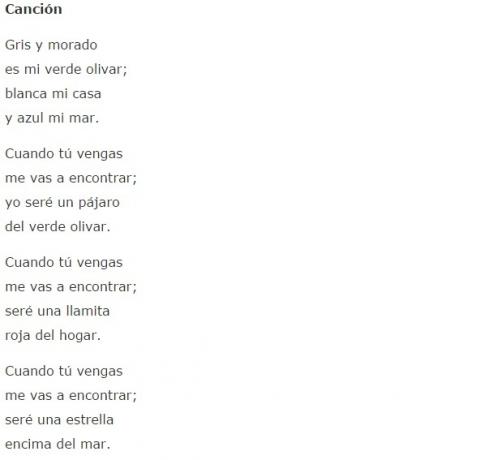Meaning of the Poem Song by José Moreno Villa
What does the poem Canción by José Moreno Villa mean:
The poem "Canción" by José Moreno Villa (Málaga, 1887-Mexico City, 1955) is a rhyme or oral tradition song collected in his book What my parrot knew, published for the first time in 1945, in Mexico.
José Moreno Villa is a Spanish intellectual exiled in Mexico that with its anthology of riddles, songs, games, sayings and folklore marked generations of children. "Song" in particular is a children's poem that has become matter of study in the fifth and sixth year classes of schools.
The poem "Song" manages to convey that joviality and energy that all children have. It paints the minds of those who sing it with a thousand colors. It also highlights the joy and anxiety that permeates the expectation of someone dear. It is most likely that he is a relative much loved by the rhythmic repetition of him in three stanzas: "When you come / you will find me."

Analysis of the poem "Canción" by José Moreno Villa
The poem "Song" is a
children's poem and it speaks for children, therefore it stands out for the rhythm, harmony and sound that facilitates their memorization. The playful element that the poet uses in this case is that of the colors.His rhyme is consonant with endings in -ar in each second and fourth verse of each stanza: olive grove (v. 2), sea (v. 4), find (v. 6), olive grove (v. 8), find (v. 10), home (v. 12), find (v. 14) and sea (v. 16).
Literary language is the stylistic and rhetorical devices used to embellish and accentuate originality. These are divided into three large groups: phonic, grammatical and semantic.
The grammatical stylistic devices that José Moreno Villa uses in the poem "Canción" are:
- Epithet: uses adjectives that highlight the characteristics of an object or person, in this case they are found in all the colors present in the poem, making it colorful.
- Anaphora: repetition of several words at the beginning of a verse or sentence, in this case: "When you come / you will find me" (vv. 5 and 6, 9 and 10, 13 and 14).
- Parallelism: consists of repeating similar structures in different verses or sentences, in this case: it's my green olive grove (v. 2); of the green olive grove (v. 8), my house white (v. 3); home red (v. 12), and blue my sea (v. 4); above the sea (v. 16).
The semantic rhetorical resources used in the poem "Song" are:
- Simile: comparison of two similarities, in this case: "I will be a little flame / red from home" (vv. 11 and 12).
- Metaphor: "I will be a star / above the sea" (vv.15 and 16).
- Hyperbaton: organize the words in a different order, in this case, the sequence of each pair of verses is the opposite. For example: Gray and purple / it's my olive green (vv. 1 and 2) would be "My olive green is gray and purple."
Poem "Song" by José Moreno Villa




